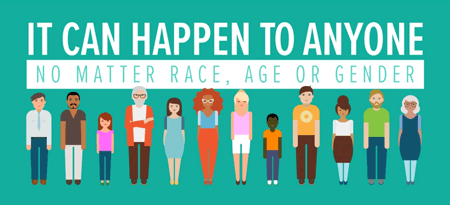Those at highest risk of any form of human trafficking are the vulnerable populations. As noted earlier, human trafficking is more common in people of low socioeconomic status or with children who experience abuse at home. While these are the most common, human trafficking does not discriminate. Red flags in spotting trafficking victims should be taught to all staff from the receptionist to the attending physicians to all ancillary departments. Everyone must be taught the signs of a potential victim the same way facilities train staff members to spot child and elder abuse.
Abuse can be emotional, physical, or sexual, and it can arise from emotional neglect, physical neglect, and family violence. All are prevalent among trafficked youths. Sexual abuse is the strongest predictor of human trafficking for both boys and girls. Those who have experienced sexual abuse in the home may be looking for a way to escape to a better life, only to find themselves manipulated into a trafficking situation.
Lack of caregiver protection from abuse in the home increases the likelihood of a child’s seeking protection from someone outside the home. Exposure to family violence is also an increased risk of human trafficking. Abusers will cultivate relationships with these young children or teens and they soon become victims. Trafficking of boys more commonly relies on emotional and sexual abuse (Reid et al., 2017).
According to the Department of Justice (2016), youth at risk for human trafficking include:
- Youth in the foster care system
- Young people who identify as LGBTQ
- Homeless or runaway youths
- Those with disabilities
- Youth with mental health or substance abuse disorders
- Youth with a history of sexual abuse
- Those with a history of being involved in the welfare system
- Those who identify as native or aboriginal
- Youth with family dysfunction (DOJ, 2016)
American Indian/Alaska Native Children
American Indian/Alaska Native children are subject to the Indian Child Welfare Act16 (ICWA) and Michigan Indian Family Preservation Act17 (MIFPA), which establish jurisdiction for state or tribal courts in child welfare matters. Native American Affairs policy and case management resources for the State of Michigan may be found on the Native American Affairs website at http://www.michigan.gov/americanindians. These resources address notice under ICWA and MIFPA, which is required for all American Indian/Alaska Native child custody proceedings in order to assist these families with culturally appropriate services and placement.
Source: HHS, 2017a.
Traffickers will specifically target runaway or “throwaway” teens who are having trouble at home. They are seen as easy targets because they are looking for shelter and may not be old enough to legally get a job. It is common for these teens to trade sex to meet basic survival needs of food, shelter, and clothes (Roe-Sepowitz et al, 2013).
Act 62 of 2016 (Human Trafficking Notification Act)
Act 62 requires the posting of certain notices relating to human trafficking. Notices required under Act 62 shall be posted in a conspicuous manner clearly visible to the public and employees within each facility open to use by the public and operated by an entity that is required to post human trafficking notices under Act 62.
Posters may be downloaded free of charge at the Wage and Hour Division website at www.michigan.gov/wagehour or by calling the Wage and Hour Division and asking that the posters be mailed to you.
Act 62 applies to the following entities:
- Welcome centers
- Rest areas
- Local bus and rail transportation services
- Public airports
- Adult entertainment establishments as defined in Section 2 of Act 62
- Entities that own property that has been found by a court to constitute a public nuisance due to acts of prostitution or human trafficking
Source: Department of Licensing and Regulatory Affairs (LARA), 2018.
For welfare children, the California Child Welfare Council found that 50% to 80% of victims of commercial sexual exploitation are or were formerly involved with the child welfare system (OTIP, 2017). Teens and children from the lesbian, gay, bisexual, or transgender community are at risk because of psychosocial vulnerabilities that have resulted from social alienation or maltreatment experiences (Gorman & Hatkevich, 2016). LGBT youth are disproportionately runaway and homeless and can be up to 5 times more likely than their heterosexual peers to be victims of human trafficking (OTIP, 2017).
The population at risk for labor trafficking often come from unstable and economically devastated places. Traffickers frequently identify vulnerable populations characterized by oppression, high rates of illiteracy, little social mobility, and few economic opportunities (OTIP, 2017).

Source: DHS, 2022.
